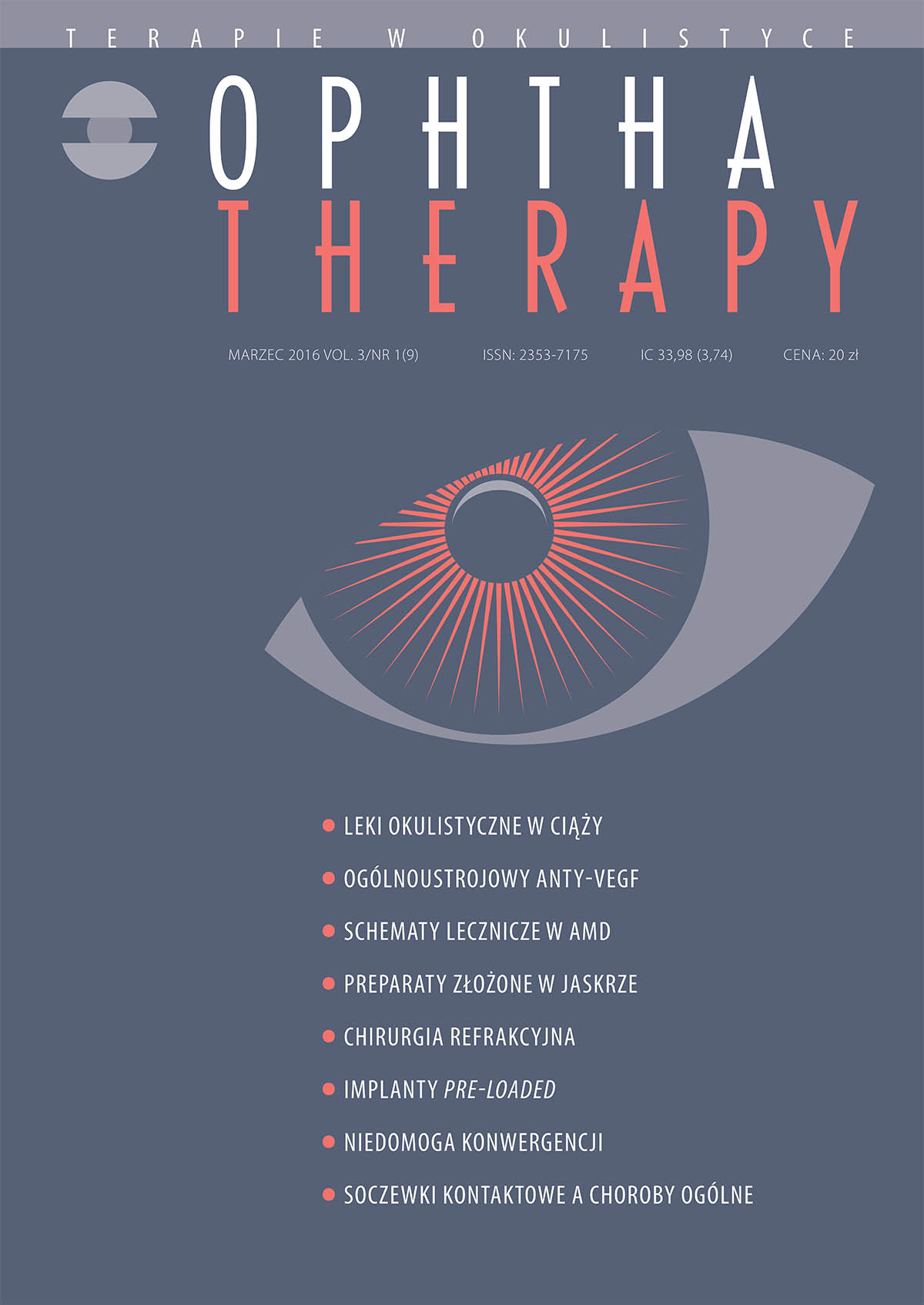Rola preparatów złożonych w prowadzeniu pacjentów z jaskrą. Leki złożone a monoterapia
##plugins.themes.bootstrap3.article.main##
Abstrakt
Jaskra dotyka miliony ludzi. Choroba ta jest jedną z głównych przyczyn utraty widzenia na świecie. Podwyższone ciśnienie wewnątrzgałkowe często towarzyszy jej progresji. Obecnie istnieje wiele metod terapeutycznych w leczeniu jaskry, ale to terapia miejscowa pozostaje leczeniem pierwszego rzutu. W artykule autorzy przedstawiają, jak ważną rolę w prowadzeniu pacjentów odgrywa leczenie wieloskładnikowymi preparatami złożonymi, gdy monoterapia jest nieskuteczna i niewystarczająca w redukcji ciśnienia wewnątrzgałkowego. Omówione zostały zalety terapii złożonej – jej skuteczność, tolerancja, wpływ na przewlekłe stosowanie i współpracę pacjenta z lekarzem. Zwrócono uwagę na najnowszy lek złożony (brimonidyna + brinzolamid), jedyny niemający w swoim składzie β-blokera. Ma to ogromne znaczenie dla pacjentów, u których terapia timololem jest przeciwwskazana.
Pobrania
##plugins.themes.bootstrap3.article.details##

Utwór dostępny jest na licencji Creative Commons Uznanie autorstwa – Użycie niekomercyjne – Bez utworów zależnych 4.0 Międzynarodowe.
Copyright: © Medical Education sp. z o.o. License allowing third parties to copy and redistribute the material in any medium or format and to remix, transform, and build upon the material, provided the original work is properly cited and states its license.
Address reprint requests to: Medical Education, Marcin Kuźma (marcin.kuzma@mededu.pl)
Bibliografia
2. The AGIS Investigators. The Advanced Glaucoma Intervention Study (AGIS): 7. The relationship between control of intraocular pressure and visual field deterioration. Am J Ophthalmol. 2008; 130(4): 429-40.
3. European Glaucoma Society. Terminology and guidelines for glaucoma. 4th edition. Publicomm, Savona, Italy 2014: 134-60.
4. Inoue K. Managing adverse effects of glaucoma medications. Clin Ophthalmol. 2014; 8: 903-13.
5. Kass MA, Heuer DK, Higginbotham EJ et al. The Ocular Hypertensive Treatment Study: a randomized trial determines that topical ocular hypotensive medication delays or prevents the onset of primary open-angle glaucoma. Arch Ophthalmol. 2002; 120(6): 701-13.
6. Reardon G, Kotak S, Schwartz GF. Objective assessment of compliance and persistence among patients treated for glaucoma and ocular hypertension: a systemic review. Patient Prefer Adherence. 2011; 5: 441-63.
7. Nordstrom BL, Friedman DS, Mozaffari E et al. Persistence and adherence with topical glaucoma therapy. Am J Ophthalmol. 2005; 140(4): 598-606.
8. Nguyen QH. Combination of brinzolamide and brimonidine for glaucoma and ocular hypertension: critical appraisal and patient focus. Patient Prefer Adherence. 2014; 8: 853-64.
9. Robin AL, Covert D. Does adjunctive glaucoma therapy affect adherence to the initial primary therapy? Ophthalmology. 2005; 112(5): 863-8.
10. Buller A, Hercules BL. Should patients choose their own eyedrops? Acta Ophthalmol Scand. 2006; 84(1): 150-1.
11. Schwartz G, Burk C, Bennett T et al. Adherence and persistence with glaucoma therapy: brimonidine/timolol versus dorzolamide/timolol and various two-bottle combinations. J Clin Exp Ophthalmol. 2012; 3(8): 1-6.
12. Inoue K, Okayama R, Higa R et al. Ocular hypotensive effects and safety over 3 months of switching from an unfixed combination to latanoprost 0.005%/timolol maleate 0.5% fixed combination. J Ocul Pharmacol Ther. 2011; 27(6): 581-7.
13. Greig SL, Deeks ED. Brinzolamide/brimonidine: a review of its use in patients with open-angle glaucoma or ocular hypertension. Drugs Aging. 2015; 32: 251-60.
14. Aung T, Laganovska G, Hernandez Paredes TJ et al. Twice-daily brinzolamide/brimonidine fixed combination versus brinzolamide or brimonidine in open-angle glaucoma or ocular hypertension. Ophthalmology. 2014; 121: 2348-55.
15. Gandolfi SA, Lim J, Sanseau AC et al. Randomized trial of brinzolamide/brimonidine versus brinzolamide plus brimonidine for open angle glaucoma or ocular hypertension. Adv Ther. 2014; 31: 1213-27.
16. Nakano T, Mizoue S, Fuse N et al. Fixed combination of travoprost and timolol maleate reduces intraocular pressure in Japanese patients with primary open-angle glaucoma or ocular hypertension: a prospective multicenter open-label study. Adv Ther. 2015; 32: 823-37.
17. Cheng JW, Cheng SW, Gao LD et al. Intraocular pressure-lowering effects of commonly used fixed combination drugs with timolol: a systematic review and meta-analysis. PLoS One. 2012; 7(9): 1-11.
18. Misiuk-Hojło M, Pyziak A. Kluczowe aspekty decydujące o wyborze leku złożonego w terapii neuropatii jaskrowej – teoria i praktyka. OphthaTherapy. 2015; Suplement 1: 9-14.
19. Holló G, Vuorinen J, Tuominen J et al. Fixed-dose combination of tafluprost and timolol in the treatment of open-angle glaucoma and ocular hypertension: comparison with other fixed-combination products. Adv Ther. 2014; 31: 932-44.

